|
|
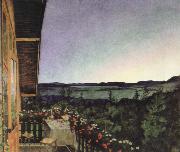 |
Harald Sohlberg
|
|
Harald Oskar Sohlberg (29 September 1869?C19 June 1935) was a Norwegian Neo-romantic painter, particularly known for his depictions of the mountains of Rondane and the town of Røros. His perhaps most well-recognized painting is his 'Fisherman's Cottage' from 1907. |
|
|
|
|
|
Helen Allingham,R,W.S
|
|
1848-1926
Studies of Flowers
Studies of Flowers .was a well-known watercolour painter and illustrator of the Victorian era. Helen Mary Elizabeth Paterson was born in Swadlincote in Derbyshire,[1] England. Her sister and her father, a doctor, died of diphtheria in 1862, and the rest of the family went to live in Birmingham. In 1867 she went to study art at the "Female School of Art", a section of what became the Royal College of Art in London, and became an illustrator of children's books. She was a great friend of Kate Greenaway. On 22 August 1874, she married William Allingham, who was almost twice her age. At the time, she was employed in illustrating some of the novels of Thomas Hardy, and they were attracted to one another when they met. Helen Allingham illustrated several books, including Six to sixteen: a story for girls (1876), Happy England (1903) and The homes of Tennyson (1905), written with her brother Arthur Paterson. After her marriage to Allingham, she became a watercolour painter, and she was the first woman to become a full member of the Royal Watercolour Society. As well as landscapes, she completed several portraits, including one of Thomas Carlyle. |
|
|
|
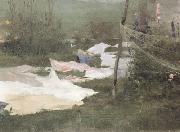 |
Helene Schjerfbeck
|
|
Finnish Painter, 1862-1946
.Finnish painter. In 1873 she began to study at the Finnish Art Society drawing school in Helsinki. On the death of her father in 1876, she was forced to seek help to finance her studies. In 1877 she went to the private academy of Adolf von Becker (1831-1909) in Helsinki, and her work was first shown in public in 1879. In the autumn of 1880 she went to Paris to study at the Academie Trelat de Vigne under Leon Bonnat and Jean-Leon Gereme and in 1881 moved to the Academie Colarossi, studying under Gustave Courtois ( fl 1852-1908) and Raphael Collin (1850-1916). In Brittany that summer, she painted a large oil, A Boy Feeding his Little Sister |
|
|
|
|
|
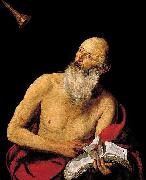 |
Hendrick van Somer
|
|
Hendrick van Someren, or Somer (1615, Amsterdam - 1685, Amsterdam), was a Dutch Golden Age painter.
According to Houbraken he was the son of the "van Zomeren" who took in the young Adriaen Brouwer after he fled Frans Hals' workshop to try his luck in Amsterdam. Houbraken claimed Henrik van Someren was a good painter of historical allegories, landscapes, and flower still lifes.
According to the RKD no works survive in the styles Houbraken mentioned, only "hermits" in the style of Ribera. He was the son of the painter Barend van Someren and the grandson of Aert Mijtens. He was the pupil of Jusepe de Ribera and at least one of his works had a forged signature of Ribera.He is possibly the same painter sometimes referred to as Enrico Fiammingo.
|
|
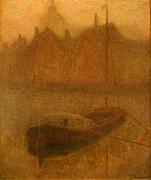 |
Henri Le Sidaner
|
|
(August 7, 1862 - July 1939) was an Intimist painter born to a French family in Port Louis, Mauritius. In 1870 he and his family settled in Dunkirk. Le Sidaner received most of his tutelage from the École des Beaux-Arts under the instruction of Alexandre Cabanel but later broke away due to artistic differences.
He travelled extensively throughout France and also visited many cities around the globe such as London, New York, Venice and Paris as well as some small villages throughout Europe. Le Sidaner exhibited at the Salon, the Galeries Georges Petit in Paris and the Goupil Gallery in London. He lived in Gerberoy, France.
Le Sidaner's work was mentioned in Marcel Proust's novel In Search of Lost Time. In Sodom and Gomorrah, the narrator mentions that an eminent barrister from Paris had devoted his income to collecting the paintings of the "highly distinguished" but "not great" Le Sidaner. |
|
|
|
|
|
|
|
|
|
|
|
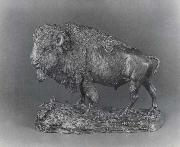 |
Henry Merwin Shrady
|
|
American Sculptor, 1871-1922,was the sculptor of the Ulysses S. Grant Memorial in Washington, D.C. Shrady was born in New York City. His father, George Shrady, was one of the physicians who attended former president Ulysses S. Grant during the struggle with throat cancer that led to his death on July 23, 1885. Shrady graduated from Columbia University in 1894 and spent one year thereafter at Columbia's law school. He left law school to join with his brother-in-law, Jay Gould (son of millionaire Edwin Gould, the financier), at the Continental Match Company. The company failed and Shrady contracted typhoid fever which diverted him forever from the business world. His recuperation left spare time to pursue a growing interest in art. Shrady's wife, Harrie Moore, submitted some of his paintings to an exhibition of the National Academy of Design without his knowledge and they sold quickly. He then began to teach himself sculpture using zoo animals and his pets as models. Shrady and architect William Casey Pearce won the competition to build the Ulysses S. Grant Memorial in 1902. In the twelve years Shrady spent executing the memorial, he studied biology at the American Museum of Natural History and dissected horses to gain a better understanding of animal anatomy. |
|
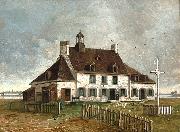 |
Henry Richard S. Bunnett
|
|
1845 -1910
David Ross McCord (1844-1930) commissioned Henry Richard S. Bunnett (1845-1910) to paint over 200 oil paintings between 1885 and 1889. The works depicted buildings, views and places around Quebec that McCord felt were of historical importance. |
|
|
|
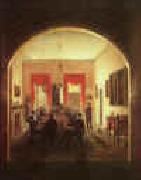 |
Henry Sargent
|
|
1770-1845
Henry Sargent Gallery
Henry Sargent (baptized November 25, 1770 ?? February 21, 1845), American painter and military man, was born in Gloucester, Massachusetts. One of seven children born to Daniel and Mary (Turner) Sargent and the brother of Lucius Manlius Sargent, he was a great-grandson of William Sargent, who received a grant of land at Gloucester in 1678. His father was a prosperous and public-spirited merchant. Henry was sent as a young boy to Dummer Academy, South Byfield, and then, the family having moved to Boston, he continued his studies under local teachers. After a period in the counting house of Thomas Handasyd Perkins, he continued his commercial apprenticeship with his father, but suddenly, as he was attaining his majority, without having previously shown special partiality for the arts of design, he determined to become an artist. An elder brother's efforts in this direction seem to have stimulated him, and his mother encouraged him. John Trumbull, who visited Boston in 1790, saw some of his work and found it promising.
In 1793 Sargent went to London, where he studied with Benjamin West and had courteous treatment from John Singleton Copley. A letter of Sargent's dated March 27, 1795 shows that he found living in London expensive and the painter's profession much depressed. He returned to Boston in 1799, still strongly conscious of "the apathy then existing towards the arts". Accordingly, in that same year he took a commission in the national army then being raised under the command of Alexander Hamilton. This service was brief, but it gave Sargent a taste for military life which motivated his long connection with the Massachusetts militia. In or shortly after 1799 he joined the Boston Light Infantry, which had been organized the year before and of which his brother, Daniel Sargent, was captain. Records of the adjutant-general's office in the Massachusetts State House show that Henry Sargent became first lieutenant of this company on October 1, 1804, and captain on March 31, 1807. Of a tall, thin, Yankee build, he was a handsome officer and an efficient drill master. During the War of 1812 his company aided in the fortification of Fort Strong, and on May 31, 1815, he was appointed aide-de-camp to the governor, with the rank of colonel. In 1812, 1815, 1816, and 1817 he was a member of the Massachusetts Senate.
On April 2, 1807, Sargent married Hannah, the daughter of Samuel and Isabella (Pratt) Welles, of Boston, and they had two daughters who died in infancy and two sons, one of whom was Henry Winthrop Sargent.
In the course of the following decade, growing deafness caused him gradually to withdraw from public services and to devote himself entirely to his painting and to mechanical inventions; he achieved no particular fame in the latter field. His painting was that of a diligent and gifted artist whose talent fell short of genius. His portraits were less masterful than those of his fellow townsman, Gilbert Stuart, with whom he was personally intimate. Like Copley, whom he somewhat resembled as a painter, Sargent enjoyed intensive elaboration of textures and accessories. He had a capacity for doing canvases that required sustained effort. The well-known Landing of the Pilgrims, at Pilgrim Hall, Plymouth, attributed to him, is not representative of his best work. Far better are the two conversation pieces, The Dinner Party (ca. 1821) and The Tea Party (ca. 1824), owned by the Museum of Fine Arts, Boston. These have something of the exquisiteness of the so-called Little Dutchmen and they give fascinating glimpses of social life in Boston homes of the early 19th century. An altar painting, The Christ Crucified, which Sargent made for the Holy Cross Church, Boston, won contemporary favor. The full-length portrait of Peter Faneuil, in Faneuil Hall, if by Sargent, to whom it is ascribed, must be a copy after John Smibert. Sargent's self-portrait is at the Museum of Fine Arts; his likenesses of Jeremy Belknap, D.D., and John Clarke, D.D., both friends of his parents, are at the Massachusetts Historical Society. Continuing to paint at intervals down into old age, he was elected in 1840 an honorary member of the National Academy of Design and in 1845, president of the newly-organized Artists' Association of Boston. |
|
|
|
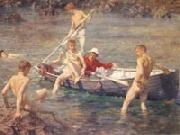 |
Henry Scott Tuke
|
|
British Painter and photographer , 1858-1929
English painter. He entered the Slade School of Art, London, in 1875, under Alphonse Legros and Sir Edward Poynter. In 1877 he won a Slade scholarship and in 1880 travelled to Italy, where he made his first nude life drawings, an important revelation to him of light, colour and the human form. From 1881 to 1883 he was in Paris and met Jules Bastien-Lepage, who encouraged his studies en plein air. |
|
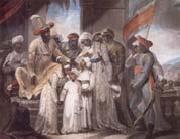 |
Henry Singleton
|
|
British Painter, 1766-1839,English painter and illustrator. His father died when he was young, and he was brought up by his uncle, the miniature painter William Singleton (d 1793). In 1782 he entered the Royal Academy Schools in London and in 1784 won a silver medal for a drawing from life, exhibiting at the Royal Academy for the first time the same year. He showed considerable promise and in 1788 won a gold medal for a painting inspired by John Dryden's ode Alexander's Feast that was especially praised by Reynolds. In 1793 Singleton was commissioned by the Royal Academy to paint the group portrait the Royal Academicians Assembled in their Council Chamber (London, RA). He soon became noted for his paintings inspired by the Bible and from literary sources, among them Manto and Tiresias (exh. 1792; London, Tate) from John Dryden's Oedipus, and for his depictions of contemporary historical events, of which the watercolour Design Commemorative of the Abolition of the Slave Trade (1807; London, BM) is an example. Many of his works were engraved in mezzotint and achieved a widespread popularity. He also painted portraits, the writer James Boswell (c. 1795; Edinburgh, N.P.G.) being one of his sitters. Many of Singleton's later works are inclined to be sentimental and were carelessly executed; they were often intended solely for engraving. |
|
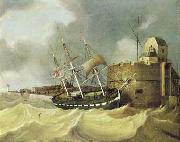 |
Henry Smartly
|
|
painted Ship QUEEN VICTORIA - a Close Call Entering Le Havre in 1843 |
|
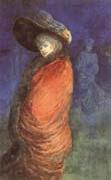 |
Henry Somm
|
|
French, 1844-1907.French painter, illustrator, designer and printmaker. He was trained at the Ecole Municipale de Dessin in Rouen under Gustave Morin (1809-86). He was obliged to sell illustrations to periodicals to make a living, contributing, among others, to Charge, Cravache, LInutile, Chronique parisienne and Courier fran?ais. His drawings were spirited, but because their humour often relied on topicality his fame was short-lived. |
|
 |
Henryk Siemiradzki
|
|
(1843-1902) was a Polish Academic painter. He was particularly known for his depictions of scenes from the ancient Graeco-Roman world and the New Testament.
Siemiradzki was born to a Polish szlachta family of a military physician in the village of Novobelgorod (now Pechenegi) near Kharkov, Ukraine. He studied at Kharkov Gymnasium where he learned painting under a scion of Karl Briullov, D. I. Besperchy. He entered the Physics-Mathematics School of Kharkov University but continued his painting lessons from Bespechy.
After graduating from the University with the degree of Kandidat he abandoned his scientific career and moved to Saint Petersburg to study painting at the Imperial Academy of Arts in the years 1864-1870. Upon his graduation he was awarded a gold medal. In 1870-1871 he studied under Karl von Piloty in Munich on a grant from the Academy. |
|
 |
Hercules Seghers
|
|
1590-1638
Dutch
Hercules Seghers Gallery
Hercules Pieterszoon Seghers or Segers (c. 1589 ?C c. 1638) was a Dutch painter and printmaker of the Dutch Golden Age. Segers is in fact the more common form in contemporary documents, and was used by the painter himself (modern use is about equally divided between the two). He was "the most inspired, experimental and original landscapist" of his period and an even more innovative printmaker.
He was probably best known to his contemporaries for his paintings of landscapes and still-life subjects; his paintings are also rare, with perhaps only fifteen surviving (one was destroyed in a fire in October 2007 ). The Stadholder, Frederick Henry, Prince of Orange bought landscapes in 1632. Many of his painted landscapes are fantastic mountainous compositions, whereas in his prints it is often the technical approach rather than the subject which is extreme. His painted landscapes tend to show a wide horizontal view, with emphasis on earth rather than sky; two in the Gemäldegalerie, Berlin had strips of sky added at the top later in the century to meet a changed taste. Apart from Coninxloo, Seghers drew from the Flemish landscape tradition, perhaps especially Joos de Momper and Roelandt Savery, but also the "fantastic and visionary aspects of Mannerist" landscape painting. A 1680 inventory of Jan van der Capelle, who owned five paintings by Seghers, describes one as view of Brussels, which if correct would presumably mean Seghers travelled there, probably when young, when his style shows most Flemish influence (in so far as the chronology of his work is clear). |
|
|
|
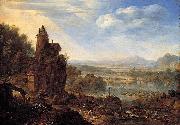 |
Herman Saftleven
|
|
(1609 - January 5, 1685 (buried)), was a Dutch painter of the Baroque period.
Born in Rotterdam, Saftleven lived most of his life (1632-1685) in Utrecht. His brothers, Cornelis Saftleven (1607-1681) and Abraham Saftleven were both painters. The former was even better known as a painter, specializing in genre scenes, while Herman was known for his landscapes of river scenes as well as of persons traveling through woods. His father, Herman Saftleven I was a painter in Rotterdam, who died by 1627. One of Herman IIes daughters, Sara Saftleven, born in Utrecht after 1633, also became a painter of flowers in watercolors. She married Jacob Adriaensz Broers in 1671.
Herman became the dean of the Guild of St Luke in Utrecht. After a storm had destroyed most of the town in the 1670s, he sold the city a series drawings he had made of Utrecht churches before they were destroyed. In the 1680s, he was commissioned by the amateur botanist and horticulturalist Agnes Block, to draw flowers and plants at her country estate near Utrecht. He died in Utrecht.
|
|
|
|
|
|
|
|
|
|
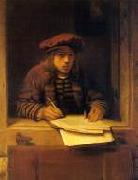 |
HOOGSTRATEN, Samuel van
|
|
Dutch Baroque Era Painter, 1627-1678
Dutch painter, draughtsman, engraver and writer. His multi-faceted art and career testify amply to the unflagging ambition attributed to him as early as 1718 by his pupil and first biographer, Arnold Houbraken. During his lifetime van Hoogstraten was recognized as a painter, poet, man of letters, sometime courtier and prominent citizen of his native city of Dordrecht, where he served for several years as an official of the Mint of Holland. Today he is remembered not only as a pupil and early critic of Rembrandt, but also as a versatile artist in his own right. His diverse oeuvre consists of paintings, drawings and prints whose subjects range from conventional portraits, histories and genre pictures to illusionistic experiments with trompe-l'oeil still-lifes, architectural perspectives and perspective boxes. |
|
|
|
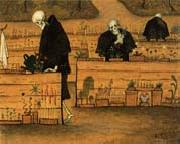 |
Hugo Simberg
|
|
Hamina 1873-1917 Ahtari, Finnish painter and printmaker. He first studied at the Finnish Fine Arts Association in Helsinki. His natural inclination towards mysticism led him to seek the instruction of Akseli Gallen-Kallela, with whom he studied in Ruovesi intermittently between 1895 and 1897. Gallen-Kallela's influence, in particular his Symbolist synthesis of the National Romantic style, is evident in Simberg's early works, such as Frost and Autumn (both 1895; Helsinki, Athenaeum A. Mus.), which are highly personal expressions of the mysticism of nature. |
|
|
|
|
|
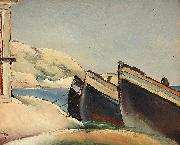 |
Ion Theodorescu Sion
|
|
Ion Theodorescu-Sion (1882-1939).
Alternative names Onu Soare Teodor.
Romanian painter.
|
|
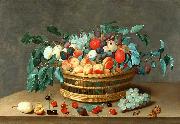 |
Isaak Soreau
|
|
painted Basket with fruit and plum leaves in c. 1640
|
|
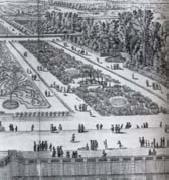 |
Israel Silvestre
|
|
French Baroque Era Engraver, 1621-1691,called the Younger to distinguish him from his father, was a prolific French draftsman, etcher and print dealer who specialized in topographical views and perspectives of famous buildings. Orphaned at an early age, he was taken in by his uncle in Paris, Israel Henriet, an etcher and printseller, and friend of Callot. Between 1630 and 1650 Silvestre travelled widely in France and Italy, which he visited three times, and later worked up his sketches as etchings, which were sold singly and in series. His work, especially of Venetian subjects published in the 1660s, influenced eighteenth-century painters of vedute such as Luca Carlevaris and Canaletto, who adapted his compositions. In 1661 he inherited the stock of plates of his uncle, the printseller Israel Henriet, among which was a large part of the works of Jacques Callot, and many of those of Stefano della Bella. In 1662 he was appointed dessinateur et graveur du Roi and in 1673 he was appointed drawing-master to Louis, le Grand Dauphin. From 1668 he was granted workshop space in the galleries of the Louvre, where the practice of housing eminent artists and craftsmen was a tradition that was originated under Henri IV. Silvestre's atelier was large: he had at least two pupils who had careers as engravers, Franqois Noblesse and Meunier, and In 1670 Charles Le Brun recommended him for membership in the Acadeemie royale de peinture et de sculpture. In 1675 his son, the artist Louis Silvestre, was born at Sceaux. |
|
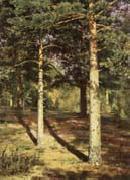 |
Ivan Shishkin
|
|
Russian Painter, 1832-1898
was a Russian landscape painter closely associated with the Peredvizhniki movement. Shishkin was born in the town of Elabuga of Vyatka Governorate (today Republic of Tatarstan), and graduated from the Kazan gymnasium. He then studied at the Moscow School of Painting, Sculpture and Architecture for 4 years, then attended the Saint Petersburg Imperial Academy of Arts from 1856 to 1860, graduating with the highest honors and a gold medal. He received the Imperial scholarship for his further studies in Europe. Five years later Shishkin became a member of the Imperial Academy in St. Petersburg and was professor of painting from 1873 to 1898. At the same time, Shishkin headed the landscape painting class at the Higher Art School in St. Petersburg. For some time, Shishkin lived and worked in Switzerland and Germany on scholarship from the St. Petersburg Imperial Academy of Arts. On his return to Saint Petersburg, he became a member of the Circle of the Itinerants and of the Society of Russian Watercolorists. He also took part in exhibitions at the Academy of Arts, |
|
|
|
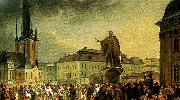 |
j. g. sandberg
|
|
Johan Gustaf Sandberg, född 1782, död 1854, var målare; han var professor i teckning vid Konstakademien från 1828, och direktör där 1845?C1853.
Sandberg ägnade sig främst åt historiemåleri, med motiv ur nordisk mytologi och svensk historia. Hans främsta verk inom detta område är kalkmålningarna över Gustav Vasa i Uppsala domkyrka. Han målade också en mängd porträtt.
Efter akademiska studier i Åbo med början 1783, och Uppsala, dit han flyttade 1788, blev han filosofie magister 1791. Han blev 1792 extra ordinarie kanslist i akademiska kansliet. Juris utriusque kandidat blev han 1792 och kort därefter docent vid juridiska fakulteten, blev juris licentiat 1800 och utnämndes 1807 till jurisprudentiä, oeconomiæ et commerciorum professor i Uppsala. Juris utriusque doktor 1810; arbetande ledamot i Lagkommissionen 1811-1814; ledamot av Krigsvetenskapsakademien 1810, Lantbruksakademien 1812, Vetenskapssocieteten i Uppsala 1829 samt flera andra lärda samfund. År 1834 erhöll han adlig värdighet och tog avsked från sin professur 1837. Lars Rabenius ligger begravd på Uppsala gamla kyrkogård. |
|
|
|
|
|
|
|
|
|
|
|
|
|
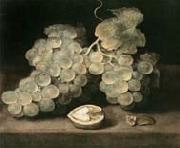 |
Jacob van Es
|
|
Flemish Baroque Era Painter, 1596-1666
was a Flemish Baroque still life painter active in Antwerp. His restrained ontbijt (breakfast) pieces share many similarities to contemporaries Osias Beert and Clara Peeters, and typically show various foods on a sharply angled table in the foreground. |
|
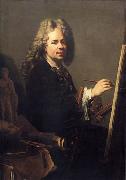 |
Jacob van Schuppen
|
|
Born in Fontainebleau, France, as the son of the painter-engraver Pieter van Schuppen, he worked in the Netherlands before moving to Vienna. He was taught to paint by his father and his uncle Nicolas de Largilliere.
In 1719 he was registered in Luneville, but he moved in the same year to Vienna where he became court painter. In 1725 he was appointed director of the Academy of Fine Arts Vienna, when it was refounded by Emperor Charles VI as the k.k. Hofakademie der Maler, Bildhauer und Baukunst (Imperial and Royal Court Academy of painters, sculptors and architecture). |
|
|

